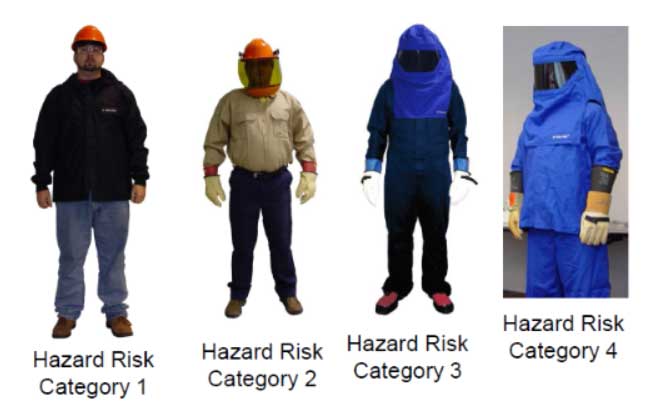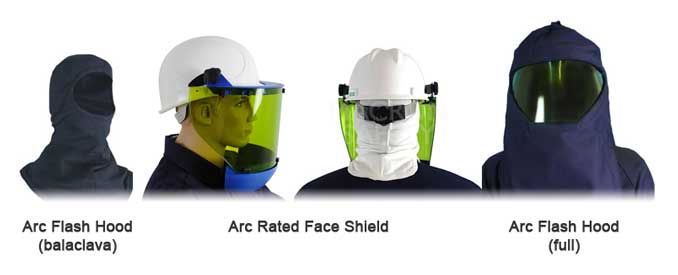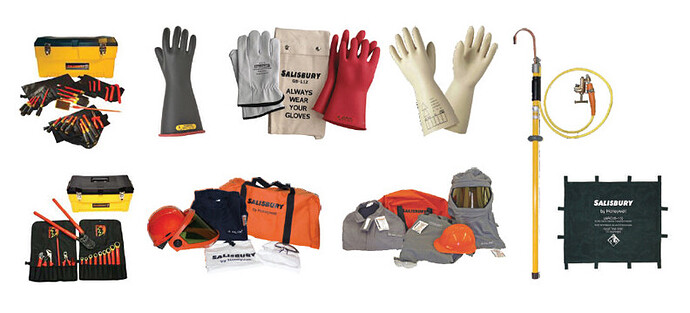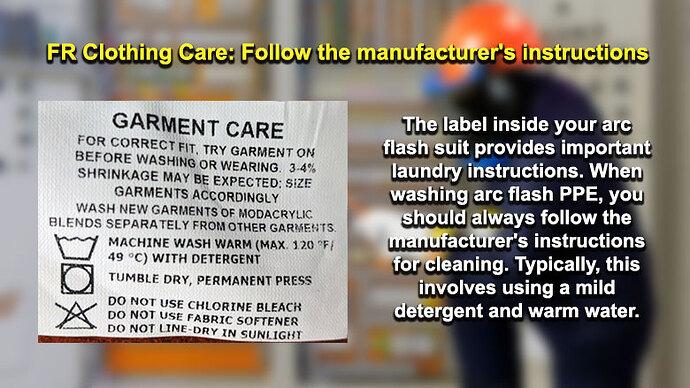Arc flash incidents can be extremely dangerous, causing severe burns and injuries if not properly protected against. Personal Protective Equipment (PPE) plays a critical role in safeguarding workers from the devastating effects of arc flashes.
However, wearing PPE alone isn’t enough; it’s essential to follow specific rules of thumb to ensure the effectiveness of your arc flash gear. In this technical brief, we’ll outline several key guidelines for arc flash PPE, focusing on proper attire, maintenance, and disposal to maximize worker safety.

The greater the electrical hazard, the higher the personal protective equipment arc rating must be to withstand an arc-flash incident. Photo: EFCOG Electrical Safety Task Group.
1. Don’t Compromise, Wear Your Arc Flash PPE
Arc flash events can occur suddenly and unexpectedly and flame resistant PPE only provides protection when it’s worn. Consistently wearing your FR gear is an essential step in preventing injuries and minimizing the potential risks associated with arc flash incidents.
By wearing the appropriate arc flash PPE for the task at hand, individuals create a barrier between themselves and the potential hazards, reducing the risk of injury. The FR clothing, gloves, and face shields are specifically designed to withstand and protect against the thermal energy, intense light, and potential projectiles that can result from an arc flash.
2. Choose the Right Clothing Underneath
Avoid clothing materials that melt under extreme heat as they may create molten droplets that can cause a secondary injury or ignite other flammable materials in the vicinity. Clothing materials that melt under extreme heat can adhere to the skin, causing more severe burns.
When synthetic fabrics or materials melt, they can stick to the skin, exacerbating the damage caused by the arc flash. This can lead to prolonged exposure to heat and thermal energy, resulting in deeper and more severe burns.
Ideal options include Arc-rated clothing or 100% natural fibers, as they do not melt. These materials help to create an additional barrier between the wearer’s skin and the intense heat generated during an arc flash event.

Arc flash hoods provide 360 degree head and neck protection from arc flash dangers, when used with an arc rated face shield.
3. Inspect to Protect
All personal protective equipment, including arc flash gear, should undergo a pre-use inspection. The purpose of this inspection is to identify any damage, wear, or defects that may compromise the effectiveness of the PPE in protecting against arc flash incidents and other electrical hazards.
During the pre-use inspection, it is important to thoroughly examine each piece of PPE for any visible signs of damage. This can include inspecting for tears, holes, frayed edges, or any other visible signs of wear. It is also essential to check for any defects in the PPE such as faulty fasteners, loose stitching, or damaged zippers.
In addition to visual inspection, it is recommended to conduct functional tests on certain types of PPE. For example, gloves should be air tested to ensure they are free from leaks, and face shields should be inspected for optical clarity. These tests help ensure that the PPE will perform as intended during an electrical incident.
If any damage, wear, or defects are identified during the pre-use inspection, the PPE should be taken out of service immediately and replaced or repaired. It is important not to use safety equipment that is compromised in any way, as it may not provide adequate protection against electrical hazards.
4. Separate Laundry for Optimal Protection
To maintain the integrity of arc flash personal protective equipment (PPE), it is important to wash it separately from other garments. This prevents cross-contamination and ensures that non-Flame Resistant (FR) or non-Arc-rated clothing does not mix with FR-rated garments. The reason behind this is that fibers from non-FR clothing can contribute to after-flame if they enter your arc flash gear.
5. Follow Manufacturer’s Instructions
It is critical to adhere to the manufacturer’s guidelines when using an arc flash suit. Inside the bibs and coat of the suit, you will typically find a label that provides essential information. This label should not be removed or cut out, as it contains important details regarding the care, use, and maintenance of the suit.
Understanding and adhering to this information is crucial for the safety of the wearer and ensures that the suit will provide the intended protection during an arc flash event.
When caring for FR clothing, you should always follow the manufacturer’s instructions for cleaning.
6. Utilize Laundry Instructions on the Label
The label inside your arc flash suit provides important laundry instructions. When washing arc flash PPE, you should always follow the manufacturer’s instructions for cleaning. Typically, this involves using a mild detergent and warm water.
It is important to avoid using bleach or fabric softeners, as they can degrade the flame-resistant properties of the clothing. Additionally, it is advisable to avoid washing arc flash PPE with heavily soiled or greasy garments, as this can also compromise the FR properties.
7. Never Reuse PPE Exposed to an Arc Flash
Reusing damaged or compromised PPE could potentially put individuals at risk in future arc flash incidents. Once an arc flash incident occurs and the PPE is exposed to the intense heat and energy, it is no longer considered safe for further use.
The extreme heat generated during an arc flash can cause significant damage to the protective materials, compromising their effectiveness in future incidents. Even if the PPE appears to be visually intact, there could be internal damage that is not visible to the naked eye.
Once an arc flash incident occurs and the PPE is exposed to the intense heat and energy, it is no longer considered safe for further use.
Remember: Protecting yourself begins with correct usage of PPE
When it comes to working in environments where arc flashes are a potential hazard, following these rules of thumb for arc flash PPE is paramount. Protecting yourself begins with consistent and correct usage of personal protective equipment, as well as maintaining it according to manufacturer guidelines.
By adhering to these best practices, workers can significantly reduce the risks associated with arc flash incidents, ensuring their safety on the job.



